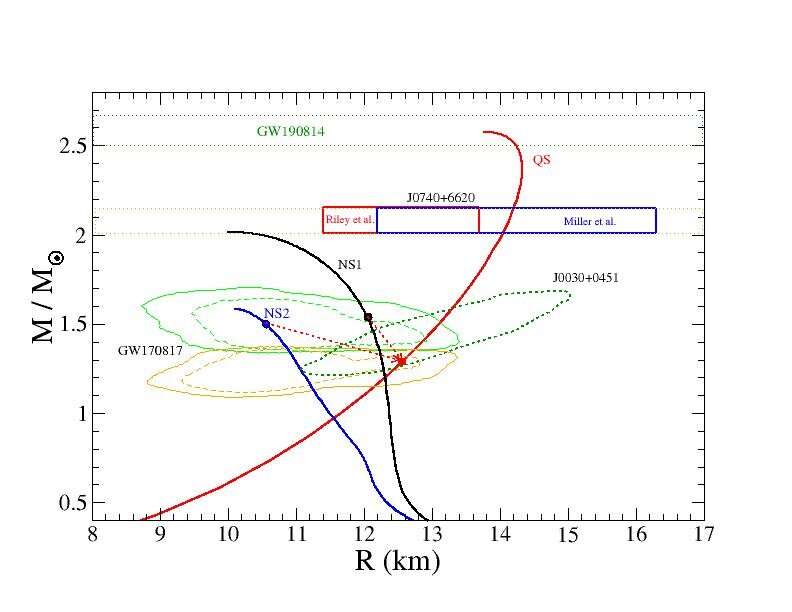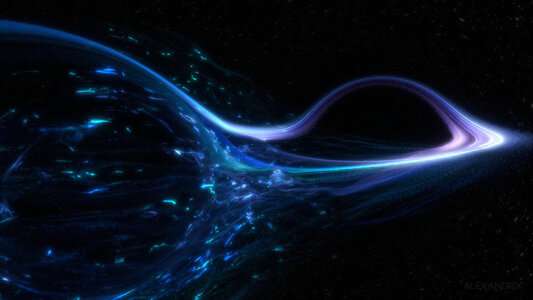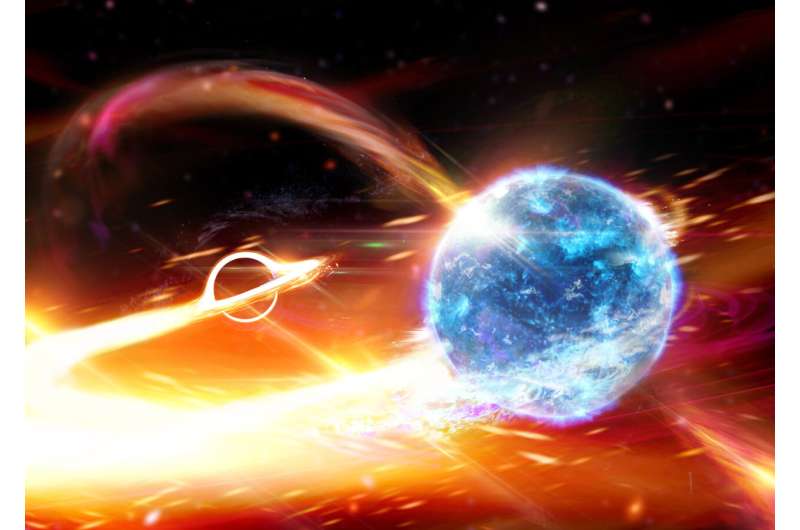June 8, 2021 feature
Could the source of the GW190814 event be a black hole-strange quark star system?

On the 14th of August 2019, the LIGO-Virgo collaboration detected a gravitational wave signal believed to be associated with the merging of a binary stellar system composed of a black hole with a mass of 23 times the mass of the sun (M⊙) and a compact object with a mass of about 2.6 M⊙. The nature of GW190814ʼs secondary star is enigmatic, since, according to the current astronomical observations, it could be the heaviest neutron star or the lightest black hole ever observed.
Researchers at University of Pisa, University of Ferrara and the National Institute for Nuclear Physics (INFN) in Italy have recently carried out a study exploring the possibility that the source of the GW190814 event detected by LIGO-Virgo is a black hole-strange quark star system. Their paper, published in Physical Review Letters, is based on an astrophysical model that they developed several years ago.
"The first condition required by our model is that the central density of massive neutron stars is high enough to allow a transition from a phase of 'normal' nuclear matter (a fluid consisting of neutrons, protons and possibly other particles such as hyperons) to a new phase which consists of a fluid made of the three lighter types of quarks, namely the up (u), down (d) and strange (s) quarks (the so-called strange quark matter)," Ignazio Bombaci, Alessandro Drago, Domenico Logoteta, Giuseppe Pagliara and Isaac Vidaña, the researchers who carried out the study, told Phys.org via email. "In addition, if strange quark matter is absolutely stable (the so-called Bodmer-Terezawa-Witten hypothesis) then the transition is first order, and 'normal' neutron stars beyond a threshold value of their mass become metastable and can be converted into strange quark stars."
The astrophysical scenario explored by Bombaci and his colleagues proposes that in nature, there are two coexisting families of compact stars, namely 'normal' neutron stars and strange quark stars. Moreover, when a neutron star is converted into a strange quark star, it releases a significant amount of energy (approximately 1053 erg), which resembles the energy released during a supernova explosion.

"A common and still popular misconception is that the phase transition to strange quark matter makes the stellar material softer i.e., more squeezable," the researchers explained. "This misconception is based on the wrong belief that quarks can be considered as non-interacting particles (ideal Fermi gas). The introduction of more sophisticated quark dynamics has unequivocally indicated that strange quark matter is quite stiff, and strange quark stars can thus have large masses up to almost about three times the mass of the sun (M⊙)."
When Bombaci and his colleagues first looked at the data associated with the gravitational wave event GW190814, specifically the value of the binary system's secondary compact object's mass (i.e., 2.50 ‒ 2.67 M⊙), they realized that this object could be part of the second family of compact stars (i.e., a high-mass strange quark star).
According to the paradigm that is currently accepted in astronomy, there is only one family of compact stars (i.e., the neutron star family). In addition, the paradigm suggests that there is a one-to-one correspondence between the central density and pressure of a neutron star and its mass and radius. This means that measuring the mass and the radius of several individual neutron stars could allow researchers to infer the relation between the pressure and density of stellar material, determining the so-called equation of the state of dense matter.
As in the scenario considered by Bombaci and his colleagues, there are two coexisting families of compact stars; their connection with the dense matter equation of state should ideally be explored from a new and different perspective.

"In our opinion, this is one of the most significant insights that our work brings to the fields of astrophysics and dense matter physics," the researchers said. "Another relevant implication is that in our scenario, there are three possible types of mergers: neutron star–neutron star, neutron star–strange quark star, strange quark star–strange quark star. The phenomenology of the mergers is therefore very different from the case in which there is only one family of compact stars."
The recent paper by Bombaci and his colleagues outlines three different types of possible mergers between stars. In addition, it suggests that if strange quark matter is absolutely stable, even dark matter could be, at least in part, made of large chunks of up, down and strange quarks. This hypothesis has not yet been ruled out by any experimental observation.
Future data collected by gravitational wave detectors combined with precise mass-radius measurements could help with further testing the hypothesis introduced by this team of researchers.
"In particular, we should have the opportunity to test our two-family scenario model against more stringent constraints," the researchers said. "We also expect to learn from the phenomenology of the mergers, in particular from the analysis of the kilonova signal: the expected signal is quite different in our scenario from the one in which only one family of compact stars exists."
More information: Was GW190814 a black hole-strange quark star system? Physical Review Letters(2021). DOI: 10.1103/PhysRevLett.126.162702.
Journal information: Physical Review Letters
© 2021 Science X Network




















